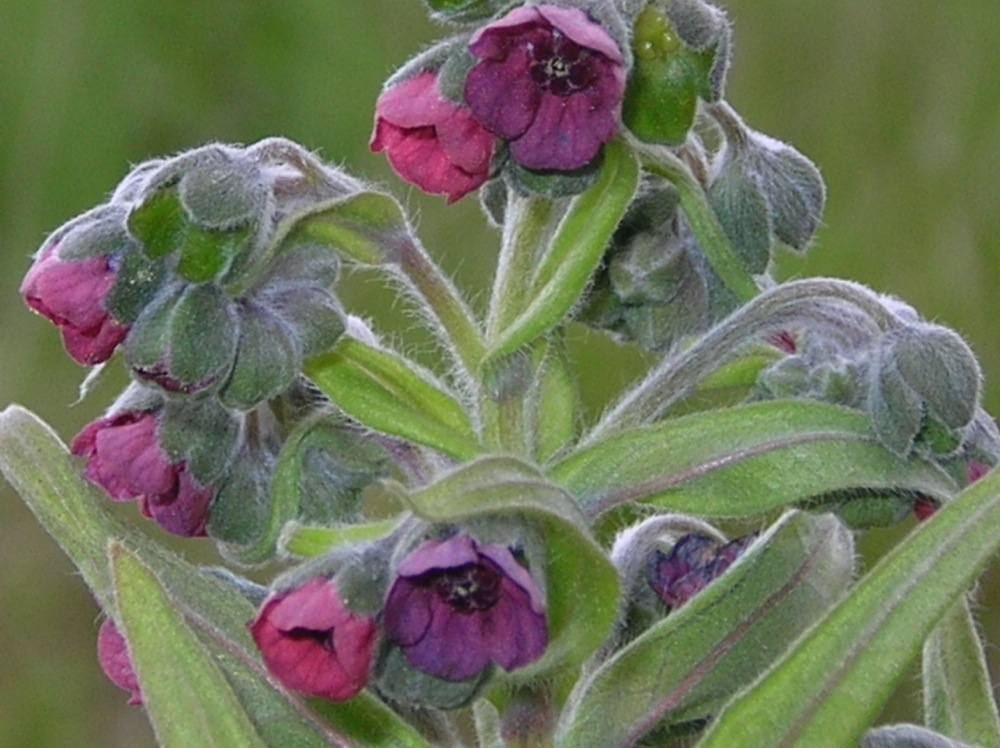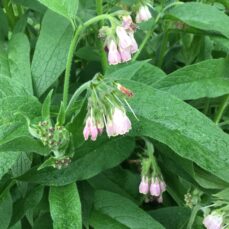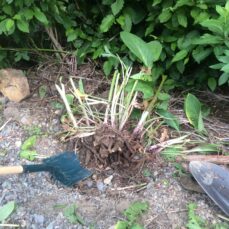Common Comfrey (Symphytum officinale)


Management Strategy
Squamish
Whistler
Pemberton
Vectors of Spread
Synonyms
- Alum
- Bohemian comfrey
- Bone-Set
- Knitbone
- True comfrey
ID Characteristics
General: Common comfrey is a perennial herb.
Flowers: Funnel-shaped with 5 shallow but distinct lobes that fuse at the base. Flowers grow in bractless, drooping clusters with several to many small flowers. Flowers can be cream or dull blue to purple, lightly striped, and are 1.5 cm – 1.8 cm long.
Stems: Covered in small, bristly hairs and grow 0.5 m – 1.2 m tall. Multiple stems grow from the base, giving the plant a bushy appearance.
Leaves: Basal, large, and alternating on the lower stem. They are either egg-shaped or oblong, 15 cm – 30 cm long and 7 cm – 12 cm wide. Leaves become smaller higher up the stem and are arranged opposite of each other.
Fruit: A cluster of 4 nutlets that turn a shiny brown-black when they mature.
Roots: Common comfrey has a branched taproot.
Similar Species
Invasive
Hound’s-tongue (Cynoglossum officinale) is not currently present in the Sea to Sky but is found in nearby regions. Unlike common comfrey, hound’s-tongue has barbed, velcro-like seeds. To add, it generally has narrower leaves, shorter, bell-shaped flowers, and wider, rounded sepals.

Native
Northern bluebells (Mertensia paniculata) is a perennial native to northwestern North America. Its deeply-lobed, bright blue flowers differentiate it from the commonly purple flowers of common comfrey.

Exotic
Prickly or rough comfrey (Symphytum asperum) is a fleshy-rooted perennial that is 0.6 m – 2 m tall, with a rough, hairy stem, and leaves that are narrow-stalked and alternate. Prickly comfrey’s flowers are shorter than those of common comfrey, and while they are also funnel-shaped, prickly comfrey flowers start out pink, later changing to sky blue.
Prickly comfrey can be found growing in inhabited areas, parks, gardens, and coastlines, but is not considered invasive in the Sea to Sky.

Common borage (Borago officinalis) is also sometimes confused for comfrey, since at first glance their flower shapes can seem similar. However, borage flowers are blue, whereas common comfrey flowers can vary in colour. While both plants have hairy leaves (and are in the same botanical family), comfrey is overall larger than borage.

Habitat and Origin
Common comfrey originates from Europe and parts of Asia, where it has been cultivated since 400 BC as a garden ornamental and a medicinal herb. It was introduced to North America in the 1600s and is still used today to treat skin irritations, cuts, sprains, and swelling; however, it is carcinogenic when ingested.
Common comfrey can be found growing in shady areas such as meadows and woods, especially near streams and rivers. It grows best in nutrient-rich soils, but can also tolerate drought conditions and disturbed soils.
How it Spreads
Common comfrey reproduces mainly vegetatively, growing new plants from root fragments. It can also reproduce by seed, though it may take up to 2 years for plants to begin growing.
Common comfrey is spread when mowed or cut as root fragments grow into new plants. It is also spread through seeding. Seeds can be transported by wind, water, humans, and animals. Additionally, it is spread through nursery sales as it is used as a garden ornamental and for medicinal purposes.
Impacts
Ecological:
- Outcompetes native plant species.
- Mines nutrients out of the soil, making them unavailable for other species.
Health:
- Hairs on stems can cause skin irritation.
- Contains pyrrolizidine alkaloids that are mutagenic and carcinogenic, and can lead to liver damage and in some cases, death.
Stop the Spread
Common comfrey is abundant in certain portions of the Sea to Sky region (i.e., Squamish and south), but has not yet infested all potential habitats. The goal is to contain the spread of common comfrey to ISMA 1.
Learn to identify common comfrey: use the images presented on this profile page to learn how to identify common comfrey.
What to do if you spot it: You can report any common comfrey sightings by visiting our reporting page.
DO:
- Regularly monitor properties for weed infestations.
- Ensure soil and gravel are uncontaminated before transport.
- Check wildflower mixes to ensure that they do not contain common comfrey.
- Minimize soil disturbances (e.g. use grazing plans that prevent soil exposure from overgrazing), and use seed mixes with dense, early colonization (e.g. alfalfa or barely) to re-vegetate exposed soil and resist invasion.
- Ensure that plants are disposed of in a garbage bag if found in floral arrangements to prevent seeds from spreading.
DO NOT:
- Unload, park, or store equipment or vehicles in infested areas; remove plant material from any equipment, vehicles, or clothing used in such areas and wash equipment and vehicles at designated cleaning sites before leaving infested areas.
- Plant common comfrey in a garden, no matter how well-contained its enclosure may seem.
- Move soil that has been contaminated with common comfrey.
- Do NOT compost!
Control
Mechanical
- Once established, common comfrey can be very difficult to remove due to its large taproot.
- If digging out, ensure that as much of the taproot is removed as possible because new plants will form from any fragments left behind.
- Removing during hot, dry weather will aid in killing off remaining root fragments.
- Mowing plants before they go to seed in the spring can prevent spread.
Chemical
- Broadleaf herbicides provide optimal control; a higher rate of herbicide will be necessary as the plant grows.
- Using a surfactant will increase coverage and ensure that herbicide penetrates the plant, as hairy bristles on the stem make it difficult.
- Triclopyr and clopyralid have proven effective for this plant, as has picloram, but the latter is not suitable for wet, coastal soils.
- We recommend that any herbicide application is carried out by a person holding a valid BC Pesticide Applicator Certificate. Before selecting and applying herbicides, you must review and follow herbicide labels and application rates; municipal, regional, provincial, and federal laws and regulations; species-specific treatment recommendations, and site-specific goals and objectives.
Cultural
- Planting competitive, native plants in areas where common comfrey has been removed will help to prevent weed occurrence.
Biological
- There are currently no biocontrol for common comfrey.
Sea to Sky Distribution
Common Comfrey Factsheet
Having trouble viewing the factsheet? Don’t worry, all the information is included on this page. You can also contact us with any questions.
References
- Electronic Atlas of the Flora of BC, Symphytum officinale
- Electronic Atlas of the Flora of BC, Symphytum asperum
- Gardenia, Symphytum officinale (Common Comfrey)
- Invasive Plant Atlas of the United States, Common Comfrey
- Invasive Species Council of British Columbia, Common Comfrey
- Minnesota Wildflowers, Common Comfrey
- Missouri Botanical Garden, Symphytum offcinale
- Nature Gate, Prickly Comfrey
- Peace River Regional District, Profile of Invasive Plant Species Within the Peace River Regional District (p. 40)
- Science Direct, Symphytum officinale
- World of Flowering Plants, Symphytum asperum (Prickly Comfrey)












